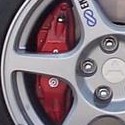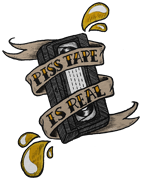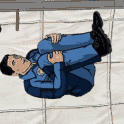|
HeyEng posted:The start switch on a Boeing 707 is utterly loving satisfying to operate. Like there ain't a doubt in the world that you're about to crank up almost 20,000 lbs of thrust. http://www.youtube.com/watch?v=ri8czC41UW8
|
|
|
|

|
| # ? May 21, 2024 16:50 |
|
I like to describe the starting cycle of the C-130 engine as like the game mousetrap. So many gears and pushrods and flyweights it's maddening to learn how it works. The engineers who built them must have been evil geniuses. But that's what happens when you directly attach a prop to a jet engine. Each engine puts 4590 hp on the prop shaft. Major torque on that thing.
|
|
|
|
D C posted:http://www.youtube.com/watch?v=ri8czC41UW8 This is why women don't understand men. Guys speaking a language I don't understand, flipping switches and making a machine start up. I watch 5 minutes of it, not understanding a word that was said, yet loving it. I look over, get a blank stare, a shake of the head. No, I do not want to watch people make ludicrous cakes, GET OUT
|
|
|
|
MrChips posted:http://www.youtube.com/watch?v=g4pqEzfKXcA basically explains it. Airliners usually use electrics to start the APU, and then the APU to start the main engines. AgentJayZ's YouTube channel is one of my two favorites, along with mastermilo82 (Dutch car hillbillies.)
|
|
|
|
These are called "Study" sims for good reason: http://www.youtube.com/watch?v=CV35B-vfT4U Starting up an A10
|
|
|
|
2ndclasscitizen posted:Something I've been curious about : How are jet engines started? On a lot of airliners, I think you can see the APU exhaust poking out of the tail cone of the aircraft.
|
|
|
|
movax posted:On a lot of airliners, I think you can see the APU exhaust poking out of the tail cone of the aircraft. Modern day APU's are almost dead silent. the APU on an AWACS is loud as all hell. It'll shake the jet on start up.
|
|
|
|
MrChips posted:http://www.youtube.com/watch?v=g4pqEzfKXcA basically explains it. Or on the SR-71, you get the engines turning with a start cart and then squirt in some triethylborane, which explodes on contact with the fuel and actually lights the engines. That's a bit of an outlier, though. HeyEng posted:Modern day APU's are almost dead silent. The APU on a Chinook is this awful high-frequency noise that'll take your ears off. Phanatic fucked around with this message at 17:12 on Jan 5, 2012 |
|
|
|
HeyEng posted:The start switch on a Boeing 707 is utterly loving satisfying to operate. Like there ain't a doubt in the world that you're about to crank up almost 20,000 lbs of thrust. Are those new engine covers in your picture? A couple of years ago they went through and replaced all the old ones with standardized boring covers. Each jet used to have their own design, each squadron had their logo on one jet's covers, and a lot of them had nicknames and awesome artwork. So naturally wing leadership decided to remove one more cool thing we had going and replace them all with covers that had the new AF logo and the tail number and that's it. I miss seeing The Joker and Miss Behavin' and all the rest. 
|
|
|
|
HeyEng posted:Modern day APU's are almost dead silent. From inside the aircraft? There's certainly no doubt when an A320 or A330 APU is running while standing on the ground.
|
|
|
|
slidebite posted:These are called "Study" sims for good reason: I spent some time with their ka-50 simulator, and the "brief" startup checklist that I wrote up from their video was something like 50 steps. And then at the end of the video the instructor just quietly says "with training actual pilots are expected to do this in 60 seconds". The a-10 startup sequence makes the ka-50 look like a piece of cake though.
|
|
|
|
Understeer posted:From inside the aircraft? There's certainly no doubt when an A320 or A330 APU is running while standing on the ground. One of the highlights of my career is reading data off a dc-9 dfdr in January on the ramp with APU and pneumatics running. Cold windy loud.
|
|
|
|
Godholio posted:Are those new engine covers in your picture? A couple of years ago they went through and replaced all the old ones with standardized boring covers. Each jet used to have their own design, each squadron had their logo on one jet's covers, and a lot of them had nicknames and awesome artwork. Yep, we have a design on ours. Just recently someone badged -0137 with a nice TURBO decal stolen off of what looks to be a Porsche. It sits right underneath the front panel engine gauges. Understeer posted:From inside the aircraft? There's certainly no doubt when an A320 or A330 APU is running while standing on the ground. Compared to what I work with daily the ones on modern airliners are a goddamn demon's whisper.
|
|
|
|
Understeer posted:From inside the aircraft? There's certainly no doubt when an A320 or A330 APU is running while standing on the ground. In that vein, the classic 737's APU is louder than all hell. With the NG's they added a silencer and it quieted down the exhaust a ton.
|
|
|
|
HeyEng posted:
I always thought it seemed odd that with 4 engines running we can still hear when the APU shuts down.
|
|
|
|
Godholio posted:I always thought it seemed odd that with 4 engines running we can still hear when the APU shuts down. A goodly chunk of airliner APUs are derived from the venerable Garrett AIResearch TPE-331, an engine that no matter how many ways/times you try to teach it good manners, it will always be the loudest fucker in the ramp.
|
|
|
|
MrChips posted:A goodly chunk of airliner APUs are derived from the venerable Garrett AIResearch TPE-331, an engine that no matter how many ways/times you try to teach it good manners, it will always be the loudest fucker in the ramp. Is there an operational incentive to make APUs quieter? For main engines, being quieter at takeoff thrust means they can be operated later at airports with noise abatement requirements, use fewer credits at LHR, and theoretically burn less fuel (noise energy is wasted energy.) And from back when I built my own computers, a big fan was always quieter than a small one.
|
|
|
|
So, explanation time. Why do we need to manually adjust the mixture on airplanes? I understand "why" it needs to be done. I happily tune my motorcycle carbs. But why do we need to adjust for altitude manually when snowmobiles can do it themselves. And your car can do it. I get this feeling that the "doing it yourself" thing has stuck around to long on aircraft engine controls. You go full rich for takeoff... There's a enrichment circuit on car carbs just for that. I understand the distaste for electronic fuel injection. Magnetos let you run the engine without an electrical system. And EFI kinda shoots that reliability out the window. But what about mechanical fuel injection? Even the stuff on the 1960's chevys had altitude and temperature compensation built in. So what gives? :-) Seems like workload that doesn't need to be on the pilot.
|
|
|
|
Nerobro posted:So, explanation time. It's probably archaic like you say but also the carbs on a plane go through a far more wide array of temperatures than a car or bike.
|
|
|
|
Aircraft have different needs than cars, and the added regulations and cost that goes along with that have their effects in addition to the possible physical penalties such as complexity and weight. That being said, not every light aircraft is powered by a carbureted engine. In fact, the fuel injection system found in the Cirrus SR-20 does compensate to provide full-rich at the current altitude, although there are still manual adjustments to be made for various reasons. There are also a couple light aircraft with FADECs that handle that sort of thing.
|
|
|
|
MagnumHB posted:Aircraft have different needs than cars, and the added regulations and cost that goes along with that have their effects in addition to the possible physical penalties such as complexity and weight. That being said, not every light aircraft is powered by a carbureted engine. In fact, the fuel injection system found in the Cirrus SR-20 does compensate to provide full-rich at the current altitude, although there are still manual adjustments to be made for various reasons. There are also a couple light aircraft with FADECs that handle that sort of thing. Aircraft do have one or two complexities that car carbs don't have. But car and motorcycle carburetors handle a much, much more difficult situation. That is "opening and closing the throttle." Given that airplanes mostly run in a narrow rpm range, at a few throttle settings, you could very effectively fuel an airplane with a separating funnel. :-) So why is offloading the mixture settings to the pilot better than having a carb do it for you? (it's not.) But I would definitely believe it's the extraordinary difficulty it is getting anything certified. What initially made me think about this, is that I was reading that a rapid throttle change to do a go-around could end up killing the engine. I've had that happen when I did a poor setup on my motorcycle carbs. It's... not a good thing. FADEC loses the handy dandy "run without electricity" feature. And I'm not even trying to make an argument for FADEC. Just... some built in self compensation. I'd probably accept the "we can't certify it" as an answer for why they're sticking with 1920's level of carbuation control. But then I'd also ask why you don't get adjustable ignition advance. :-)
|
|
|
|
On the subject of starting up airliners, I've noticed a weird noise several times, always on Airbuses. Usually around the time we are taxiing to the runway, it sounds like an electric screwjack being tightened down to the shutoff point, over and over again a few dozen times. My first though was maybe fuel transfer pumps, but why wouldn't they just let them run rather than just bumping them over and over?
|
|
|
|
sandoz posted:On the subject of starting up airliners, I've noticed a weird noise several times, always on Airbuses. Usually around the time we are taxiing to the runway, it sounds like an electric screwjack being tightened down to the shutoff point, over and over again a few dozen times. My first though was maybe fuel transfer pumps, but why wouldn't they just let them run rather than just bumping them over and over? I've heard that too. Does http://www.airliners.net/aviation-forums/tech_ops/read.main/257503/ describe it? Edit: http://www.youtube.com/watch?v=9ffJgk1-tCA&feature=related https://www.youtube.com/watch?v=9ffJgk1-tCA Cocoa Crispies fucked around with this message at 23:03 on Jan 6, 2012 |
|
|
|
BonzoESC posted:I've heard that too. Does http://www.airliners.net/aviation-forums/tech_ops/read.main/257503/ describe it? Yep, that's the sound alright. Although that thread doesn't really clear it up.
|
|
|
|
sandoz posted:Yep, that's the sound alright. Although that thread doesn't really clear it up.
|
|
|
|
The power transfer unit is doing what its name implies and actually transferring hydraulic pressure from the operational system to the non-powered system, not just balancing things. Each hydraulic system actuates specific systems, and generally you'd like them all working.
|
|
|
|
BonzoESC posted:Is there an operational incentive to make APUs quieter? For main engines, being quieter at takeoff thrust means they can be operated later at airports with noise abatement requirements, use fewer credits at LHR, and theoretically burn less fuel (noise energy is wasted energy.) There is a push right now to minimise the use of APUs on the ground. More and more airlines are installing ground power provisions at their gates. Ideally, the APU would only be fired up just before pushback, but that assumes there aren't other needs onboard, such as environmental control. Of course, this is irrelevant with an aircraft like the 787, where all of its needs can be driven from ground or gate power.
|
|
|
|
Nerobro posted:Why do we need to manually adjust the mixture on airplanes? I understand "why" it needs to be done. I happily tune my motorcycle carbs. Many newer engines do autmatically lean themselves automatically. The Rotax 912 comes to mind. It probably is just a case of it always being manual. The mixture control is also used to kill the engine by leaning it in most light aircraft which can come in handy if your "needs no electricity" ignition system has a bad ground connection and refuses to stop firing.
|
|
|
|
Alright, a couple of months ago I said that my company was making a shipment via Antonov 225 Myira. It turns out everyone telling me that was wrong, it was "only" an An-124. Also I couldn't get within 400 yards of the thing. But here you go anyway: It's coming back again in a couple of weeks, and I'm doing my damndest to ingratiate myself with the people who can get me up close. I've captured video twice of F-15E's doing touch-and-gos, but both times there was an issue that made for lovely video (First time I didn't get my camera out until the last time around, so there was no lit afterburner and high-G turn that pointed the exhaust nozzles right at me for maximum volume. Second time it was ruined by wind noise.) Also, my route home takes me past the end of the runway. On my way out of work today I noticed a C-130 on approach, so I pulled off and parked to wait for it to fly over. Didn't get my phone out in time to film it, but it went less than 50 yards above me coming in. I've been thinking about joining the Air National Guard lately, and I'd really like to fly C-130's. That desire predated today, though.
|
|
|
|
Nerobro posted:So, explanation time. I think the longevity of manual mixture controls is due to a few reasons, primarily based on the fact that they're reliable, pretty flexible, and (relatively) cheap. On carburated engines, a manual mixture control is very simple from a mechanical standpoint, whereas an automatic leaning system requires considerably more moving parts (especially since fully digital systems have only recently become available), which increases the odds of something failing. Manual mixture controls also allow the pilot a large amount of flexibilty that an automatic system could have trouble duplicating. As an example, a manual mixture control lets the pilot lean for best economy, best power, lean of peak, or even an over-rich setting to help cool an overheating engine. While an automatic system could certainly lean for those settings, the pilot would still have to tell it which one to use, which isn't reducing the workload too much. Modern fuel injected engines generally have very accurate CHT and EGT indicators (along with a "lean assist" mode in many aircraft) which makes it very easy for the pilot to lean for whatever condition is appropriate for the situation, without needing to add the cost and complexity of another system to the airplane. Also, keep in mind that a completely automatic mixture system would be incredibly costly to certify for what would be a marginal benefit. A Garmin GTN750 GPS (which is about as capable as an iPad) runs about $17,000, and requires far fewer parts than a completely automatic mixture control, so I doubt an automatic mixture would ever generate enough cost or workload savings to justify the massive costs of certifying a system and installing it on an airplane.
|
|
|
|
iyaayas01 posted:ITT post wacky refueling pictures: I get the Voodoos (Why the dark one? USAF/USN?) but what the heck is that boat? GIS + Wiki + Process of elimination lead me to a Martin Mars? Weren't those only transports before being made water bombers?
|
|
|
|
ecureuilmatrix posted:I get the Voodoos (Why the dark one? USAF/USN?) but what the heck is that boat? Not Voodoos, Navy F9F Cougars. I'm not familiar enough with mid-1950s USN paint schemes to tell you for sure why the different paint scheme, but I'm pretty sure that it's just a transitional thing...at the time the Navy was moving from the Korean era sea blue schemes (like what's in "The Bridges at Toko-Ri") to the grey schemes that you see on their Vietnam era aircraft. As for the flying boat, it is a Convair R3Y Tradewind (Convair being the successor to Consolidated Aircraft, of PBY Catalina and PB2Y Coronado flying boat fame; the aircraft was actually originally designed P5Y, keeping the Consolidated designation). It was designed post-WWII to be a successor to those two aircraft in the patrol bomber role; however, the Navy decided to forgo that, instead choosing to make the aircraft a passenger and cargo transport. The later R3Y-2 had a hinged nose; they were intended to serve as "flying LSTs," with the hinged nose enabling them to beach and unload their cargo directly that way. They were later modified with four point probe and drogue refueling gear, which is how that picture came to be. The Tradewind's service life was relatively short, because as with many '50s era aircraft it was plagued with engine problems.
|
|
|
|
e: goddammit that'll teach me to post before going to do something else 
|
|
|
|
ecureuilmatrix posted:I get the Voodoos (Why the dark one? USAF/USN?) but what the heck is that boat? It's actually a Convair R3Y Tradewind. The Tradewind was only in service from 1956-58, and only 13 were ever built (all of which were scrapped), so it's not a very well known aircraft. edit: beaten twice.
|
|
|
|
Understeer posted:The power transfer unit is doing what its name implies and actually transferring hydraulic pressure from the operational system to the non-powered system, not just balancing things. Each hydraulic system actuates specific systems, and generally you'd like them all working. The E-3 is easy. We have a ground power sensing relay tied to an interconnect switch that when taken to system mode will connect the aux hydro system to the utility (engine-driven pumps) system. No crazy European noises either!
|
|
|
|
iyaayas01 posted:Not Voodoos, Navy F9F Cougars. I'm not familiar enough with mid-1950s USN paint schemes to tell you for sure why the different paint scheme, but I'm pretty sure that it's just a transitional thing...at the time the Navy was moving from the Korean era sea blue schemes (like what's in "The Bridges at Toko-Ri") to the grey schemes that you see on their Vietnam era aircraft. Crud, I saw high tail + triangular wingroot intakes, thought Voodoo right away. In my defense, I am Canadian and recently went to the Museum in Ottawa. Also, thanks for that Tradewind story, quite fascinating.
|
|
|
|
azflyboy posted:
These are good points. But lean of peak is mostly used in fuel injected aircraft that can have the cylinders balanced much more accurately than carbed aircraft which have a single one on a manifold. In addition to Rotax, the Jabiru engine also has altitude compensation in its Bing carbs. But they're both used in LSA/ultralight types which don't fly very high anyway - but lean of peak would certainly be nice in a slippery Czech carbon fiber tadpole. 150 knots on a Rotax 912 is excellent fuel economy even without leaning. More startup porn: https://www.youtube.com/watch?v=g9fkmqPHTDE https://www.youtube.com/watch?v=AlPnGp22c34 And one for the old old school: https://www.youtube.com/watch?v=WkPFRpbSU9o If anyone has played IL-2, you'll recognize the sound. The flywheel note pitches down as it clutches in and loses rpm while transferring kinetic energy to the engine. Although in that game you didn't get the spectacle of the flywheel spinning up and all planes had the same sound effect.
|
|
|
|
MrChips posted:There is a push right now to minimise the use of APUs on the ground. More and more airlines are installing ground power provisions at their gates. Ideally, the APU would only be fired up just before pushback, but that assumes there aren't other needs onboard, such as environmental control. Of course, this is irrelevant with an aircraft like the 787, where all of its needs can be driven from ground or gate power. Exactly; reducing their use with cleaner and quieter stuff is much better than incremental improvements; just like replacing cars with cycling.
|
|
|
|
 Saw it and thought it was AI as all hell. 
|
|
|
|

|
| # ? May 21, 2024 16:50 |
|
Exi7wound posted:
Is that a Spit intercepting a V-1?
|
|
|


































